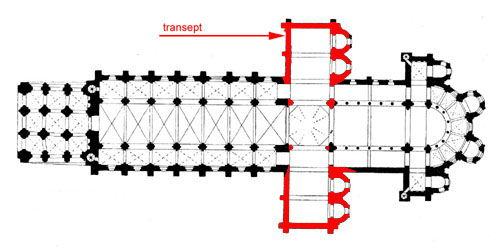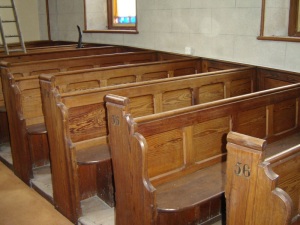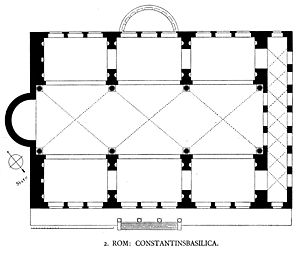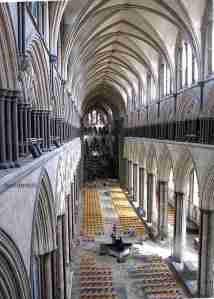Pew Pew Pew
http://online.wsj.com/news/articles/SB20001424052702303918804579107171202971150
This article laments the loss of the pew. To really appreciate the change, some history is needed.
Christians originally met up in houses. The first church buildings were not based upon the pagan temples, or even the Jewish temple, since these were the homes of gods/God. Instead, Christians built the first churches with a basis of public halls. Basilica comes from a Greek work for “ruler”, and was the description of a building from which a magistrate would sit at one semicircular end to rule and provide justice and mercy. The chair of the bishop was in place of the magistrates chair, and through him Jesus was considered to reign over the people.
Note the absence of chairs shown in the diagram, as this was a meeting hall where people would chatter about. Also note how the columns are placed similar to many great medieval cathedrals.
Due to the persecution which faced the early Church, occasionally the meetings were forced underground. It is not probable that the Roman authorities didn’t know where they met, but rather that all the tunnels were hard to adequately police and therefore escape was easier. One underground catacomb church basilica could handle upwards of two thousand people! Sadly, the catacomb method didn’t always help escapes, as Pope Sixtus and four deacons were caught in the catacombs and promptly executed.
As time passed, the basilica style had arms (transepts) added to turn it into a cross.
 Still, people would normally stand or kneel during a service, but not sit; although some wealthy people would bring chairs. Slowly, starting in the 13th century, benches were added at the sides, and these then shifted to the middle of the church so that the majority of people could sit down for parts of service. However, this was mostly a Protestant innovation (after the early 1500’s) — with Catholics picking up on the idea only later on.
Still, people would normally stand or kneel during a service, but not sit; although some wealthy people would bring chairs. Slowly, starting in the 13th century, benches were added at the sides, and these then shifted to the middle of the church so that the majority of people could sit down for parts of service. However, this was mostly a Protestant innovation (after the early 1500’s) — with Catholics picking up on the idea only later on.
Because the wealthy used to bring chairs, initially pews were rented out. The church would provide the pew for a fee so that the wealthy wouldn’t need to pack up their chairs every week and bring them to church. Incidentally, this is one of the reasons why there are Free Methodists. Part of why the Free Methodists split from the Methodists in 1860 was because they rejected the idea of renting pews.
One large reason for the addition of seating in churches was that Protestants shifted worship away from Jesus present in the Eucharist and towards an understanding of Jesus present in his Word (i.e. the Bible). This mostly takes place in the form of sermons on a variety of topics, as opposed to Catholics using the homily technique of only teaching about the readings for the day. Not coincidentally does the Catholic reliance upon homily cause great consternation among Catholics on the political right. There is not much room to talk about abortion or same sex “marriage” if one is limited to talking about the readings prescribed for the day. The use of a sermon allows bringing in a much wider variety of biblical passages, and therefore themes politically relevant today are easier to touch upon. To sum up, Catholics hear much less teaching on Sunday, as we focus on the consecration which requires our reverence by standing or kneeling. Protestants are more likely to require chairs or pews because their services don’t require the physical participation of the congregation and their sermons are much longer than our homilies, so require rest.
We now enter a new phase in churches, in which the economy of a bench is giving way to the flexibility of chairs. As Catholics view their sanctuary as sacred, it is unlikely we’ll have chairs in Catholic Churches any time soon. The reverence necessary for the Eucharist means the Sanctuary won’t be turned over to a soup kitchen. However, it is admirable that those without the real presence of Jesus do turn their sanctuaries into dining rooms for the hungry, as mentioned in the article. I hope that trend continues.


